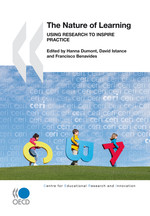Centre for Educational Research and Innovation - CERI
The Nature of Learning: Using Research to Inspire Practice
Key messages || Executive summary || Table of contents || How to obtain this publication || Other Information
|
ISBN: 9789264086470 Click book cover to read, share and embed on your website
|
The Nature of Learning: Using Research to Inspire Practice
What do we know about how people learn? How do young people’s motivations and emotions influence their learning? What does research show to be the benefits of group work, formative assessments, technology applications, or project-based learning and when are they most effective? How is learning affected by family background? These are among the questions addressed for the OECD by leading researchers from North America and Europe. This book brings together the lessons of research on both the nature of learning and different educational applications, and it summarises these as seven key concluding principles.
The Nature of Learning: Using Research to Inspire Practice is essential reading for all those interested in knowing what research has to say about how to optimise learning in classrooms, schools and other settings. It aims, first and foremost, to inform practice and educational reform. It will be of particular interest to teachers, education leaders, teacher educators, advisors and decision makers, as well as the research community. |
Why such interest in learning?
Over recent years, learning has moved increasingly centre stage for a range of powerful reasons that resonate politically as well as educationally across many countries, as outlined by Dumont and Istance (Chapter 1). These define the aims of this important volume from the work on Innovative Learning Environments produced by OECD’s Centre for Educational Research and Innovation (CERI ).
OECD societies and economies have experienced a profound transformation from reliance on an industrial to a knowledge base. Global drivers increasingly bring to the fore what some call “21st century competences”. The quantity and quality of learning thus become central, with the accompanying concern that traditional educational approaches are insufficient.
Similar factors help to explain the strong focus on measuring learning outcomes (including the Programme for International Student Assessment [PISA ]) over the past couple of decades, which in turn generates still greater attention on learning. To move beyond the diagnosis of achievement levels and shortcomings to desirable change then needs a deeper understanding of how people learn most effectively.
The rapid development and ubiquity of ICT are re-setting the boundaries of educational possibilities. Yet, significant investments in digital resources have not revolutionised learning environments; to understand how they might requires attention to the nature of learning.
The sense of reaching the limits of educational reform invites a fresh focus on learning itself: education has been reformed and reformed again in most OECD countries, leading many to wonder whether we need new ways to influence the very interface of learning and teaching.
The research base on learning has grown enormously but many researchers observe how inadequately schools tend to exemplify the conclusions of the learning sciences. At the same time, far too much research on learning is disconnected from the realities of educational practice and policy making. Can the bridges be made to inform practice by this growing evidence base?
- Foreword
- Executive summary
- Chapter 1. Analysing and designing learning environments for the 21st century (Read the Korean version)
- Chapter 2. Historical developments in the understanding of learning
- Chapter 3. The cognitive perspective on learning: ten cornerstone finding (Read the Korean version)
- Chapter 4. The crucial role of motivation and emotion in classroom learning
- Chapter 5. Learning from the developmental and biological perspective
- Chapter 6. The role of formative assessment in effective learning environments
- Chapter 7. Co-operative learning: what makes group-work work?
- Chapter 8. Learning with technology
- Chapter 9. Prospects and challenges for inquiry-based approaches to learning
- Chapter 10. The community as a resource for learning - an analysis of academic service-learning in primary and secondary education
- Chapter 11. The effects of family on children’s learning and socialisation
- Chapter 12. Implementing innovation: from visionary models to everyday practice
- Chapter 13. Future directions for learning environments in the 21st century
How to obtain this publication
Readers can access the full version of The Nature of Learning: Using Research to Inspire Practice choosing from the following options:
-
The online edition via iLibrary.
-
Purchasing a copy via our Online Bookshop.
-
Order from your local distributor.
-
Government officials can go on OLIS.
-
Access by password for accredited journalists.
- Korean version of Chapter 1: Analysing and designing learning environments for the 21st century
- Korean version of Chapter 3: The cognitive perspective on learning: ten cornerstone finding
- Innovative Learning Environments
-
Related Documents
